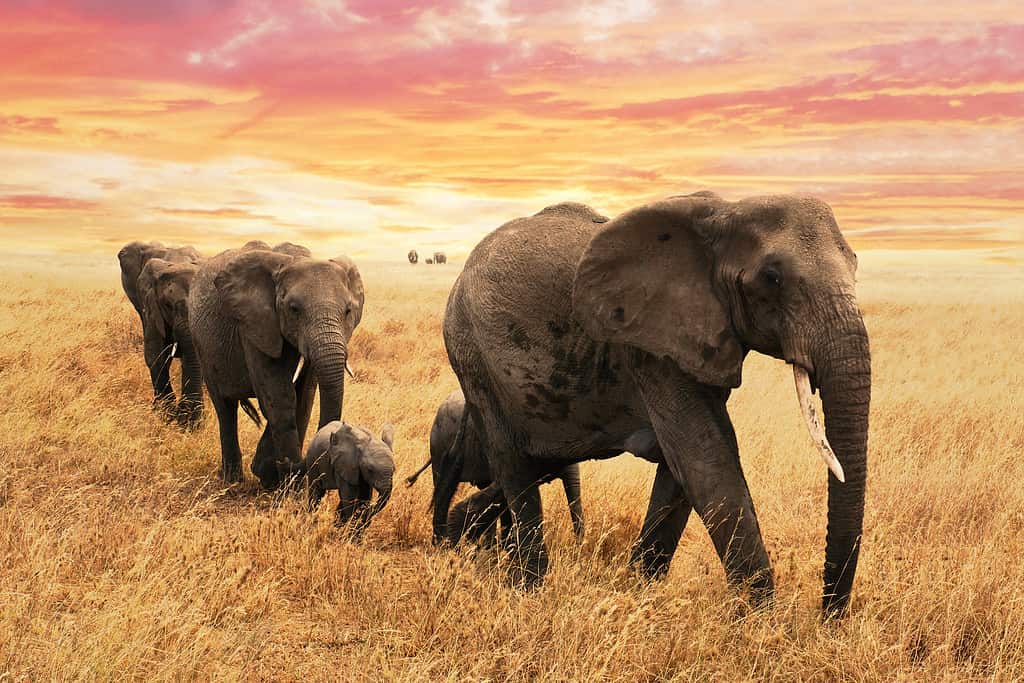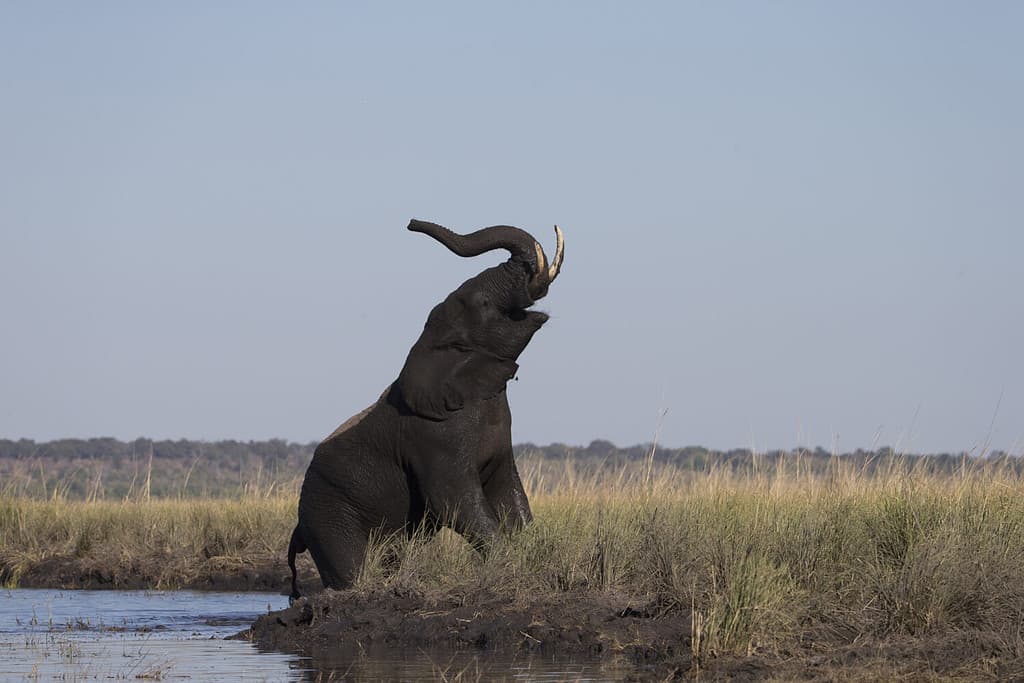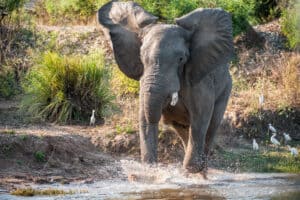These imposing creatures have long symbolized strength and wisdom. They have the power to crush with a single stomp, but their instincts are to protect their herd and eat plant materials. They are gentle but fierce when the moment calls for it. Their behaviors in the wild are fascinating but something happens when they are held in captivity. They start to display unusual behaviors. Discover why elephants sway back and forth! Plus, learn more about these creatures, including conservation efforts underway to protect them.
Elephant Overview
These massive mammals are notably clever and have a distinctive appearance. Not only are they towering animals standing at 10 feet tall, but they also have long protruding trunks that they use for various reasons, from helping their young move along to drinking water and eating. They are mighty powerful, but they’re known for their generally gentle disposition. They have large ears that can flap wildly and tusks that emerge from either side of their trunks. Unfortunately, poachers have long been killing these animals for their tasks, which is why conservation efforts are vital to ensure their existence.
There isn’t only one type of elephant. There are three main species. There is the Asian elephant, the African savanna elephant, and the African forest elephant. Depending on the species, they range in size. They can reach up to 14,000 pounds! Though enormous and commanding, these animals are not predators. They’re herbivores, snacking on various plant material throughout their lives. Sometimes they go through the leaves hanging off the branches of a tree and other times they eat the roots and bark of the tree. Being that they’re so large, they need plenty of food sources to survive. They need a high availability of food daily and when it gets scarce, they migrate.

As elephants migrate in search of food sources, each step they take serves the ecosystem.
©TeamDAF/ via Getty Images
Why Elephants Sway Back and Forth
Elephants are strongly bonded with their families. They’re social creatures that rely on their groups, which are called herds. Within their social structure, they communicate in various ways, sometimes with vocalizations and other times with body language. Interestingly they can also communicate via infrasound, which is a low-frequency sound that they can hear across vast distances. So, when an elephant is not in its natural environment, experiencing connection with its herd, it experiences distress.
When an elephant is kept in captivity, it starts to sway or rock its body back and forth. Elephants used in circus acts, for example, are in a completely unnatural environment. All of their instincts are suppressed, and they’re made to perform tasks for human entertainment. This can stress out an elephant, which results in these unusual movements. Elephants need regular physical activity and space along with mental stimulation to operate as healthy animals. But when they’re kept in captivity, especially in cramped environments, they get understandably frustrated.
To relieve the anxiety that they feel in such an unnatural environment, they develop the coping mechanism of swaying. It’s sort of like when you tap your foot when you’re waiting for something or you’re bored, or when you wring your hands before a big oral presentation. You develop self-soothing mechanisms to discharge some of the excess energy you have during a particularly trying time. Elephants, too, have developed this coping mechanism to sway as they endure unnatural conditions.
Elephant Habitat
An elephant’s natural habitat depends on the species. For example, Asian elephants live in Asia and enjoy wetlands and grasslands as well as tropical environments. On the other hand, African elephants live in different parts of Africa. The African forest elephant thrives in dense, forested environments in the western and central regions of the continent while the African savanna elephant flourishes in open environments like savannas. However, they inhabit forested environments as well. They live primarily in the southern and eastern regions of Africa.
Elephant Behavior
When observed in the wild, you can appreciate the natural behavior of elephants. You can see just how close-knit their herds are and what kind of societal structure they’ve created. Typically, elephant herds are led by a matriarch. The matriarch of a herd is the oldest female of multiple generations. However, males may form their own herds without a matriarch. These are bachelor herds that allow them to maintain a supportive social structure.
You can probably imagine the sound an elephant makes when it’s trumpeting. Though that’s the most common sound you think of when considering elephants, they also make a range of other sounds. They might purr or chirp, too! They use infrasound to communicate amongst themselves. They are constantly communicating using these vocalizations with one another but they’re also expressing themselves via body language as well.

Elephants use a range of vocalizations, including trumpeting, to communicate with their herd.
©Dennis W Donohue/Shutterstock.com
An elephant’s emotional capacity is highlighted by how they grieve. Since they live in herds, they are closely bonded with one another. When one member of the herd passes away, the rest of the herd sticks around, sometimes touching the dead body with their trunks. They stand around the way humans do during a funeral service, surrounding the body, acknowledging the death, and mourning together. Their capacity for understanding unveils their capacity for suffering.
Elephant Conservation
Some elephant populations are not classified as vulnerable or endangered but in certain regions like central and east Africa as well as Asia, their numbers have been dwindling. According to the World Wildlife Fund, Asian elephant numbers have plummeted by at least 50%, which affords them the classification as endangered. In central and eastern Africa, there are just over 400,000 elephants, which affords them the classification as vulnerable. Without caring about this, poachers continue killing elephants, which is taking some of their populations to the brink of extinction.
Elephants make up an integral part of the different ecosystems in their respective habitats. For example, Asian elephants help with the maintenance of both forest and savanna ecosystems. As they move through dense forests, they carve out paths that other animals utilize. Something as simple as where an elephant steps allows the opportunity for micro ecosystems to thrive. For instance, an elephant’s footprint is deep enough and permits water to puddle.
This then allows smaller organisms like tadpoles to thrive. Elephants help to disperse seeds and they clear canopy coverings, which allows trees to regenerate. Their presence alone allows other animals to flourish. African elephants are just as vital to their ecosystems. For instance, many of the native plants in central Africa need to pass through an elephant’s digestive system to germinate. According to the World Wildlife Fund, at least 1/3 of all of the forest trees in the central region of Africa depend on elephants.
Conservation Efforts
The conservation of elephants requires a multi-pronged approach. One method is to address the conflict between humans and elephants. Determining what the underlying issues are and working to rectify those issues requires intentional communication. That sometimes means using tools like electric fencing to protect crops. Anti-poaching initiatives are another method by which organizations help to protect endangered species. Identifying illegally trafficked ivory helps to cut down on the illegal ivory trade. Protecting the habitats of these gentle giants along with other efforts helps to keep elephants from becoming extinct.
The African Wildlife Foundation and the World Wildlife Fund are just two organizations that focus on conservation. Although they need boots on the ground to assist with fighting against the illegal ivory trade and the protection of habitats, the simple act of learning and sharing what you learn about elephants helps to bring the topic into spaces that otherwise remain uninformed. If you’re wondering what you can do, start there. You can also donate, petition governments, and work toward stopping wildlife crime.
The photo featured at the top of this post is © Johann Mader/Shutterstock.com
Thank you for reading! Have some feedback for us? Contact the AZ Animals editorial team.







